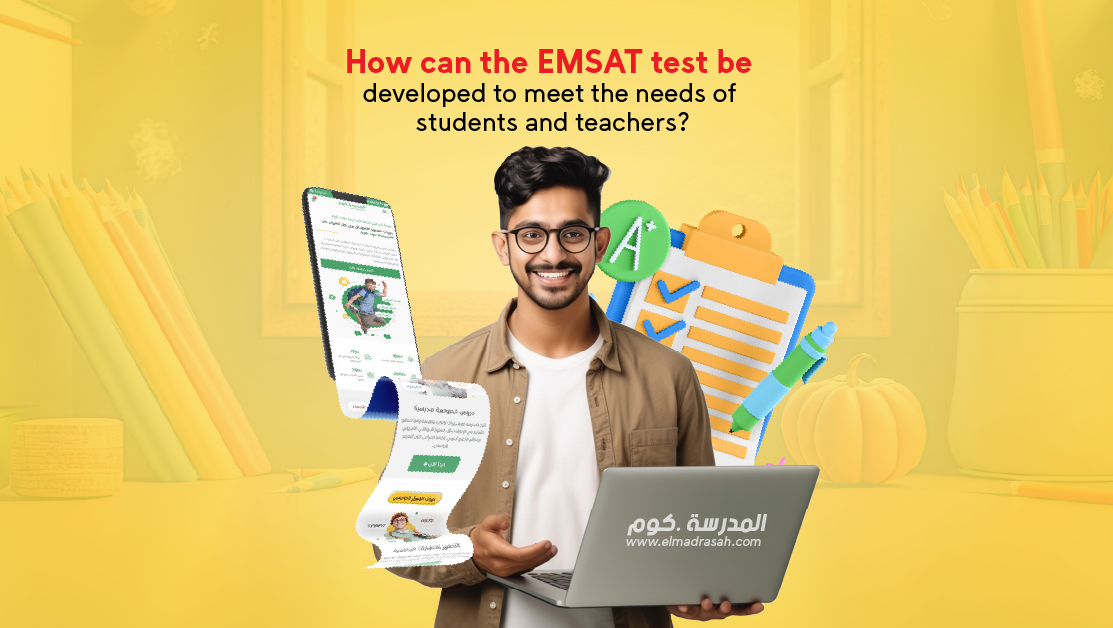
The Emirates the EMSAT test poses a significant challenge for both students and educators alike. It’s more than just an ordinary test; it’s a gateway to higher education opportunities and future career paths. This test requires the ability for quick analysis and critical thinking, adding extra pressure on both students and educators. In this article, we will explore the challenges of the EMSAT test and possible solutions to meet the needs of students and educators and achieve success in this critical task. We will also discuss the importance of this test as a crucial stage in students’ educational journey and the development of their academic skills.
Analyzing the Challenges of EMSAT Testing: Assessing Academic Abilities and Time Pressure
Examinations are one of the most important means of assessing students in the educational system, aiming to measure their understanding of the subjects and concepts taught. However, students and educators face many challenges during the preparation and administration of exams, including comprehensive assessment of academic abilities and time constraints.
One of the key challenges students face in exams is the comprehensive assessment of their academic abilities. When it comes to exams, students must be able to apply the concepts and information taught systematically and appropriately. Some students may struggle with problem-solving and applying knowledge in new and unfamiliar contexts. Some may find it challenging to engage in critical thinking and apply higher-order skills such as analysis, concentration, and innovative thinking. Assessing these academic abilities can be challenging for many students, as they must apply these skills under the pressure and time constraints of the exam conditions.
Time pressure is another challenge that students and educators face during exams. Students must complete multiple tasks and solve problems within a very limited time frame, increasing levels of stress and psychological pressure. This pressure can affect students’ performance and their ability to think clearly and logically, leading to confusion and distraction, ultimately affecting the final exam results. Additionally, educators may also feel pressured to assess students and correct answers within a short period, especially when dealing with a large number of students.
To overcome these challenges, several measures and strategies can be taken. Academically, students can prepare well for exams by regularly reviewing the curriculum and understanding the core concepts. They can also practice solving past questions and exercises regularly to increase their confidence and improve their thinking and analytical skills.
Regarding time pressure, students can practice simulated tests under realistic conditions to simulate the pressure and limited time of the exam. They can also develop time management strategies, such as allocating appropriate time for each question and arranging questions according to difficulty. Educators can also provide additional guidance and support to students in dealing with psychological pressure and stress control.
Furthermore, educators can take steps to alleviate the challenges related to assessing academic abilities. They can design tests that encompass a wide range of required skills and concepts, encouraging students to engage in critical thinking and apply knowledge in various contexts. They can also organize diverse educational activities aimed at developing students’ higher-order skills, such as analysis, concentration, and innovative thinking.
Analyzing the challenges of EMSAT testing helps us understand the difficulties that students and educators face during exam preparation and administration. By adopting effective strategies and providing appropriate support, these challenges can be overcome, leading to better performance in exams and enhancing comprehensive learning for students.
Examples of Challenges in the EMSAT test: Clarifying the Complexity of the Test and its Impact on Students and Educators
Examinations are a crucial aspect of the educational journey, presenting numerous challenges for both students and educators. Let’s review some realistic examples of difficulties that can be encountered in the EMSAT test to illustrate the complexity of the test and its impact on students and educators.
- Time Pressure: Time pressure is a major challenge in the EMSAT test. Within a limited time frame, students must solve problems and answer questions. These challenges can particularly affect students who struggle with time management, leading to lower-quality answers and impacting final results.
- Multiple-Choice Tests: Multiple-choice tests pose another challenge in the EMSAT test. Students may find it difficult to choose the correct answer among available options, especially if questions are formulated similarly or if there are distractor choices. This challenge may increase stress levels and affect critical thinking and decision-making ability.
- Assessing Higher-Order Skills: the EMSAT test requires students to apply higher-order skills such as analysis, concentration, and innovative thinking. Students may struggle to apply these skills within a limited time frame and under the pressure of exams. This challenge may result in an inaccurate assessment of students’ abilities and underutilization of their higher-order skills.
- Difficulty and Diversity of Questions: Students may face difficulty in tackling complex or unexpected questions in the EMSAT test. These questions may require deep understanding of concepts and complex analysis of information. It may be challenging for students to apply acquired knowledge and concepts in new and different question contexts. This diversity in questions requires students to adapt and engage in flexible critical thinking.
- Stress and Anxiety: the EMSAT test can cause high levels of stress and anxiety for students. Performance pressure and the feeling of evaluation can affect their concentration and ability to respond effectively to questions. This challenge may impact students’ performance and diminish their opportunities to demonstrate their true skills and knowledge.
- External Factors: Students may encounter challenges from external factors that affect their performance in the EMSAT test. The student’s surrounding environment, such as noise, distractions, or personal pressures beyond their control, can have a significant impact. This may negatively affect students’ concentration and clear thinking during the exam.
Facing these challenges and many others in the EMSAT test can have a significant impact on both students and educators. Educators and educational institutions must be aware of these challenges and work to provide the necessary support and resources for students to address them. By using diverse assessment methods and providing equal opportunities for students to express their knowledge and skills, the examination experience can be improved, and potential negative effects can be mitigated.
Proposal for Practical Solutions to Overcome Examination Challenges
The challenges faced by students and educators in the EMSAT test requires effective solutions to enhance the testing experience and reduce potential negative impacts. Below are some suggestions for offering practical solutions to achieve this:
- Providing Additional Educational Resources: Schools and educational institutions can provide additional educational resources for students before the examination period. These resources may include curriculum summaries, quick reviews, practice worksheets, and mock exams. Providing these extra resources helps students better prepare and enhance their understanding of important materials and concepts.
- Offering Training Courses for Students and Educators: Specialized examination training courses can be organized for students and educators. These courses can provide tips and strategies for dealing with examination challenges, including time management, question-answering techniques, and problem analysis. Additionally, courses can provide students with practical exercises and references to help them practice and improve necessary skills.
- Developing Innovative Assessment Methods: There should be a focus on developing innovative assessment methods that better reflect students’ abilities and knowledge. Diversifying question formats and designing them in different ways can encourage critical thinking and creativity. Comprehensive assessment methods that consider factors other than final results, such as active participation in class and collaboration, can also be utilized.
- Providing Psychological Support and Motivation: Psychological support should be provided to students during the examination period. Counseling sessions can be offered to help students deal with stress and anxiety. Additionally, positive encouragement and support from teachers and parents can boost students’ confidence in their abilities and motivate them to perform well in exams.
- Creating a Comfortable Testing Environment: The testing environment should be comfortable and appropriately conducive for students. Quiet and comfortable spaces can be provided for students to take exams, with adequate lighting and ventilation. Necessary tools and materials should also be fully and orderly provided to avoid any unnecessary stress or strain.
- Promoting Comprehensive Learning: Comprehensive learning should be promoted instead of solely focusing on the EMSAT test. Schools should focus on developing students’ fundamental skills, such as critical and analytical thinking, creativity, and communication. Various activities and projects that encourage students to apply what they have learned in real contexts should be implemented, helping them develop their skills comprehensively.
These suggestions should be supported by effective planning and implementation by schools, educators, and educational institutions. Collaboration is necessary to ensure the provision of a supportive and conducive environment for students during the examination period. By implementing these practical solutions, student satisfaction can be enhanced, and their performance in exams can be improved, contributing to the promotion of comprehensive learning experience and academic success.
Continuous Development Encouragement: Schools, teachers, and students should be encouraged to continuously develop
Rapid technological advancements and changes in society and the job market pose significant challenges to the education system in the modern era. Therefore, it becomes necessary for schools, teachers, and students to be aware of the latest educational methods and technologies and to use them effectively to achieve their educational goals.
One of the challenges students face when entering university is the EMSAT test. To achieve good results in these tests, schools, teachers, and students must embrace the concept of continuous development and utilize the latest educational methods and technologies.
Firstly, schools must play an active role in encouraging continuous development. Schools should stay informed about the latest innovations and methods in education and base their work on research and successful experiments. Continuous training opportunities should be provided for teachers to develop their skills and improve their teaching methods. Additionally, schools can enhance cooperative learning and use modern educational technology to improve the learning experience and promote deep understanding of subjects.
Secondly, teachers play a crucial role in achieving continuous development. Teachers should have a willingness to learn and improve continuously. They can participate in professional training programs, workshops, and conferences to stay updated on the latest research and educational practices. They can explore the use of modern educational technologies such as e-learning and multimedia to enhance student interaction and comprehension.
Furthermore, teachers can adopt innovative teaching methodologies such as project-based learning and active problem-based learning. To address the challenges students face in the EMSAT test, students must have a strong motivation for continuous development. Students can be motivated by highlighting the practical importance of the subjects and clarifying the relationship between knowledge and success in life. Additionally, providing an educational environment that encourages critical thinking, creativity, and collaboration among students can be beneficial. Interactive teaching methods and innovative learning techniques such as project-based learning and experiential learning can enhance students’ interaction and comprehension of subjects.
Overall, there should be a comprehensive focus on continuous development in the education system. Financial and technical support should be provided to schools and teachers to adopt the latest educational methods and harness technology for effective learning. Collaboration between schools, universities, and other educational institutions can be encouraged to exchange best practices and promote continuous learning.
In conclusion, continuous development should be a primary goal for schools, teachers, and students. By adopting the latest educational methods and technologies, benefiting from continuous training and learning, the EMSAT test scores can be improved, enabling students to face cognitive and professional challenges in the future. All stakeholders must work together to provide a stimulating educational environment and promote a culture of continuous learning to achieve continuous improvement in the education system.
How to pass the EMSAT exam?
the EMSAT test is a significant challenge for many students, serving as an important measure of knowledge and understanding in various subjects. To successfully overcome this test according to the latest updates in the EMSAT test, students need to adopt effective strategies and prepare well. In this article, we will discuss some tips and guidelines that can help you achieve positive results in the EMSAT test.
- Planning and Preparation:
Planning and preparation are crucial for your success in the EMSAT test. Identify the subjects that the test will focus on and study them intensively. Analyze past question patterns and understand the nature of the test so you can focus on key points and basic concepts.
- Create a Study Plan:
Direct your efforts in creating a solid study plan. Allocate appropriate time for each subject and try to distribute the time appropriately to cover all important topics. Set daily and weekly goals and stick to them in order of priority.
- Review and Effective Study:
Review the material regularly and systematically. Use appropriate study techniques such as rereading, summarizing concepts, and creating review cards. Try to take advantage of multimedia learning tools and online educational resources.
- Solve Previous Questions and Practice:
Practice solving previous questions and mock exams to familiarize yourself with the question patterns and assess your level of readiness. These questions can be helpful in identifying topics that need more attention and focus.
Time management is crucial in the EMSAT test. Divide your allocated time appropriately so you can complete all questions in the test. Allocate a specific time for each question and try to adhere to it. If you find difficulty in answering a particular question, leave it and move on to the next question, returning to it at the end of the test if you have enough time.
- Carefully Understand the Questions:
Before answering the questions, read them carefully and make sure you understand them correctly. Questions may contain technical terms or ambiguous expressions, so analyze and interpret them accurately before answering.
- Focus and Calmness:
Maintain your focus and composure during the test. Psychological pressure may be high, but it is necessary to remain calm and avoid drifting into negative thinking. Use deep breathing techniques and focus on the current question without thinking about previous or subsequent questions.
- Check Answers:
Once you complete the test, try to review your answers before submitting them. Make sure you understand the questions correctly and that your answers are logical and supported by correct knowledge. Correct any spelling mistakes or inaccuracies you may have made.
- Rest and Relaxation:
Do not forget to give yourself some rest and relaxation before the test. Good sleep, healthy nutrition, and physical activity can positively affect your performance in the test.
- Self-Confidence:
Lastly, but not least, maintain self-confidence in yourself and your abilities. Remember that the test is just a means of measuring current knowledge and does not necessarily determine your future. You may have prepared well and done your best, which is what matters in the end.
By using these tips and guidelines, you can increase your chances of successfully passing the EMSAT test. Remember that good preparation and self-confidence are the keys to success in any exam.















